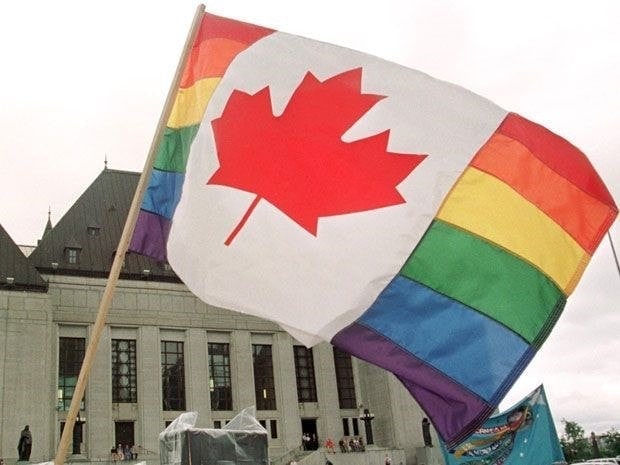
By Jeff Baillargeon
On this day in CDN queer history, the Supreme Court of Canada ruled in M v. H, 1999—a landmark case for gay rights and family law—that section 1 and 29 of the Ontario Family Law Act violated section 15 of the Charter in limiting spousal benefits to heterosexual couples.
A lesbian couple, M and H had lived, and owned a business together, since 1982. Upon their separation M was informed that she could not sue her former partner for spousal benefits as the FLA only extended this benefit to heterosexual couples. In other words, same-sex couples were not considered common-law under the co-habitation rules that guided the section 1 of the FLA.
To be a common-law couple is to be in an economically inter-dependent relationship whereby the partner who takes care of the home is financially supported by the wage-earning partner. In doing so, this latter partner is understood to alleviate “claims on the public purse by privatizing the costs of family breakdown,” as justices Cory and Iacobucci argued.
In an 8-1 majority, the Court ruled that section 1 and 29 of the FLA violated section 15 of the Charter of Rights and Freedoms in its assumption that only heterosexual couples can cohabit in an economically inter-dependent relationship. As the justices argued, this understanding promotes the view that homosexual couples are “less worthy of recognition and protection,” and that they are “incapable of forming intimate relationships of economic interdependence as compared to opposite-sex couples.”The act, they continued, “perpetuates the disadvantages suffered by individuals in same-sex relationships and contributes to the erasure of their existence.”
As a paper by the Osgoode Law Society argues, by 1999 “a pattern of favourable rulings from lower courts and administrative tribunals, changes in the membership of the Court, and a steady increase in public support for the recognition of the rights of gay and lesbian couples, combined to create the conditions in which the Court was emboldened to start closing the gap between constitutional promise and legislative reality.” The Charter, introduced in 1982, and the reading-in of sexual orientation into section 15—the equal protection from discrimination clause—in 1993, had constitutionally guaranteed equal rights, but in the legislature things were different. For example, in 1994, the Bob Rae government in Ontario had attempted to pass a legislation extending spousal benefits to same-sex couples, but was defeated in a 68-59 vote.
Despite this reticence in the legislature, the Court, for fear of being accused of judicial activism once again as in the 1993 Vriend v. Alberta case, restricted itself from providing a suitable common-law definition for legislators. Instead, the Court warned that “declaring section 29 of the FLA to be of no force and effect may well affect numerous other statutes that rely upon a similar definition of the term ‘spouse.’ The legislature may wish to address the validity of these statutes in light of the unconstitutionality of section 29 of the FLA” (emphasis mine). It is why the Osgoode paper cites this case as the moment when the Court essentially told the legislature that it is “[t]ime to clean up your acts.”
But what was clear by this point, however, was that the Court understood same-sex couples to be as valid as heterosexual couples in constituting a family, even though the matter of equal marriage would not be addressed until 2005. In 1993, for example, justice L’Heureux-Dubé had rebutted the family fundamentalism argument with her remark in Mossop that “[i]t is not anti-family to support protection for non-traditional families,” and that “[t]he traditional family is not the only family form, and [that] non-traditional family forms may [even] equally advance true family values.”
On this same day, six years later in 2005, Jason Perrino and Colin Snow of Yellowknife, Northwest Territories, contested the jurisdiction’s marriage laws that discriminated against homosexual couples. At this time, it was one of five jurisdictions left in Canada to not recognize same-sex marriages (Nunavut, Alberta, Prince Edward Island and New Brunswick).
Though the Court did not rule on the matter, as it was settled in June of that same year by the federal government, it did rule that the government of the territory award the couple $5,000 to pay for the legal fees incurred.
The primary reason, however, for the Court’s eventual inability to provide a verdict on the matter was a result of an intervening party, the “pro-family” Ruby and Laurin Trudel, who delayed the trial in their attempt to gain party status to the case. In the end, the couple could no longer afford the legal fees, and opted to represent themselves in the Court. Ruby—in a statement that has now been heard by same-sex couples many times over—explained that she and her husband were not homophobic, but rather, simply concerned Christians about the status of family life in Canada. As she stated, “[w]hile we do not support, encourage or endorse their lifestyle, we hold nothing against them personally.”
But, as the Lifesite News online media source suggests, when the Judge ordered the $5,000 reimbursement, the Christian-right nevertheless were ‘appalled’ that ‘their taxpayer’ money would be given to this homosexual couple. As the Osgoode paper writes, at the time of debate in the House of Commons, only a small majority of the Canadian population supported same-sex civil unions (53%).
Today, however, that number is much higher, sitting around 2/3rd of the population. Despite this, it is important to recognize that 10% oppose all forms of recognition of same-sex unions, and that 15% only support civil union, not same-sex marriage. This means that roughly a quarter of the Canadian population is still ill at ease with the idea of same-sex marriage.
As there was a dissonance between the “constitutional promise and legislative reality” in 1999, there is today still a dissonance between the legislative promise and the reality of public opinion—one that, though small, we ought not to forget still exists.

